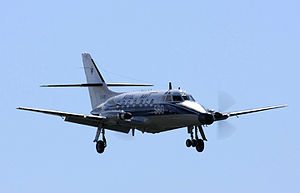Handley Page Jetstream
| Jetstream | |
|---|---|
 |
|
| Royal Navy Jetstream T2 | |
| Role | Regional airliner |
| Manufacturer |
Handley Page Scottish Aviation |
| First flight | 18 August 1967 |
| Introduction | 1969 |
| Retired | Royal navy 2011 RAF 2003 |
| Status | Active with Uruguayan Navy |
| Produced | 1967–1975 |
| Number built | 66 |
| Developed into |
BAe Jetstream 31 BAe Jetstream 41 |
The Handley Page HP.137 Jetstream is a small twin-turboprop airliner, with a pressurised fuselage. The aircraft was designed to meet the requirements of the United States commuter- and regional airline market. The design was later improved and built by British Aerospace as the BAe Jetstream 31 and BAe Jetstream 32 featuring different turboprop engines.
Handley Page was in an awkward position in the 1960s, wishing to remain independent of the "big two" British companies (Hawker Siddeley and the British Aircraft Corporation), but without the money needed to develop a large new airliner that would keep it in the market. After studying the problem it decided that its next product would be a highly competitive small airliner instead, filling a niche it identified for a 12–18 seat high-speed design. American salesman and modification engineer Jack Riley claimed to have written the design specifications. The design garnered intense interest in the US when it was first introduced, and an order for 20 had been placed even before the drawings were complete. Charles Joy was responsible for the design.
The original design dates from 1965 as a 12-seat (six rows with a centre aisle) aircraft. The aircraft was a low-wing, high-tail monoplane of conventional layout. Considerable attention was paid to streamlining in order to improve performance, which led to one of the design's more distinctive features, a long nose profile. The fuselage had a circular cross-section to ease pressurisation, allowing much-higher-altitude flights and consequent higher speed and comfort than competing unpressurised designs. One drawback of the design was that fuselage was so small in cross-section that the cabin floor had to be "lowered" to allow stand-up passenger entry and egress through the rear door. This meant that the main spar had to run through the cabin, causing a tripping hazard.
...
Wikipedia
